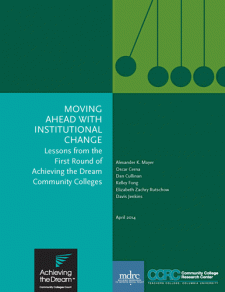Moving Ahead with Institutional Change
Lessons from the First Round of Achieving the Dream Community Colleges

In 2004, Lumina Foundation launched Achieving the Dream, a national initiative aimed at cultivating systemic change in community colleges, with the ultimate goal of increasing student success, particularly among low-income students and students of color. Now encompassing nearly 200 institutions across the country, Achieving the Dream aims to help community colleges build a “culture of evidence” by increasing their capacity to collect and use data in order to identify barriers to success and to subsequently develop intervention strategies.
In 2011, MDRC and the Community College Research Center published Turning the Tide: Five Years of Achieving the Dream in Community Colleges. That report described the implementation of the initiative and student outcome trends, through 2009, for the first 26 colleges that joined Achieving the Dream in 2004 (called the “Round 1” colleges). This report builds on Turning the Tide in two ways. First, it extends the analyses of student outcomes through 2011, to include students who were entering the Round 1 institutions during the latter period of the colleges’ five-year implementation grants, when institutions were expected to have more fully implemented many of their Achieving the Dream initiatives. Second, the report explores variation in student outcome trends in Round 1 colleges and reanalyzes the implementation data, seeking lessons to inform other colleges that are undertaking reforms.
Overall, this report finds that average institution-wide student outcome trends remained relatively stable during the period of study, including during the prolonged recession that began in the United States in late 2007. Three colleges, however, stood out for gains on multiple indicators of student success. Although this report cannot directly link practices at these colleges to gains in student outcomes, their experiences do suggest lessons for community college practitioners, in addition to new directions for research. In particular:
- Each college focused on specific student subgroups, and each coordinated multiple reform efforts around their chosen subgroup.
- In later years, after gaining experience with the initial subgroups, each college expanded the reach of new practices to include larger groups of students or faculty. This focus was supported by targeted professional development for faculty and staff involved in the work.
- One college also used its reaccreditation process to help coordinate its reform efforts toward achieving a common set of goals.
This report marks the end of a long-term study on the first colleges to join Achieving the Dream. The initiative was designed to tackle persistently low rates of student success in community colleges. The Round 1 colleges have demonstrated that even while change can occur at the institutional level, for example, becoming a more data-driven college, substantially improving institution-wide student outcomes is more challenging and much harder than was envisioned at the start of the initiative.







